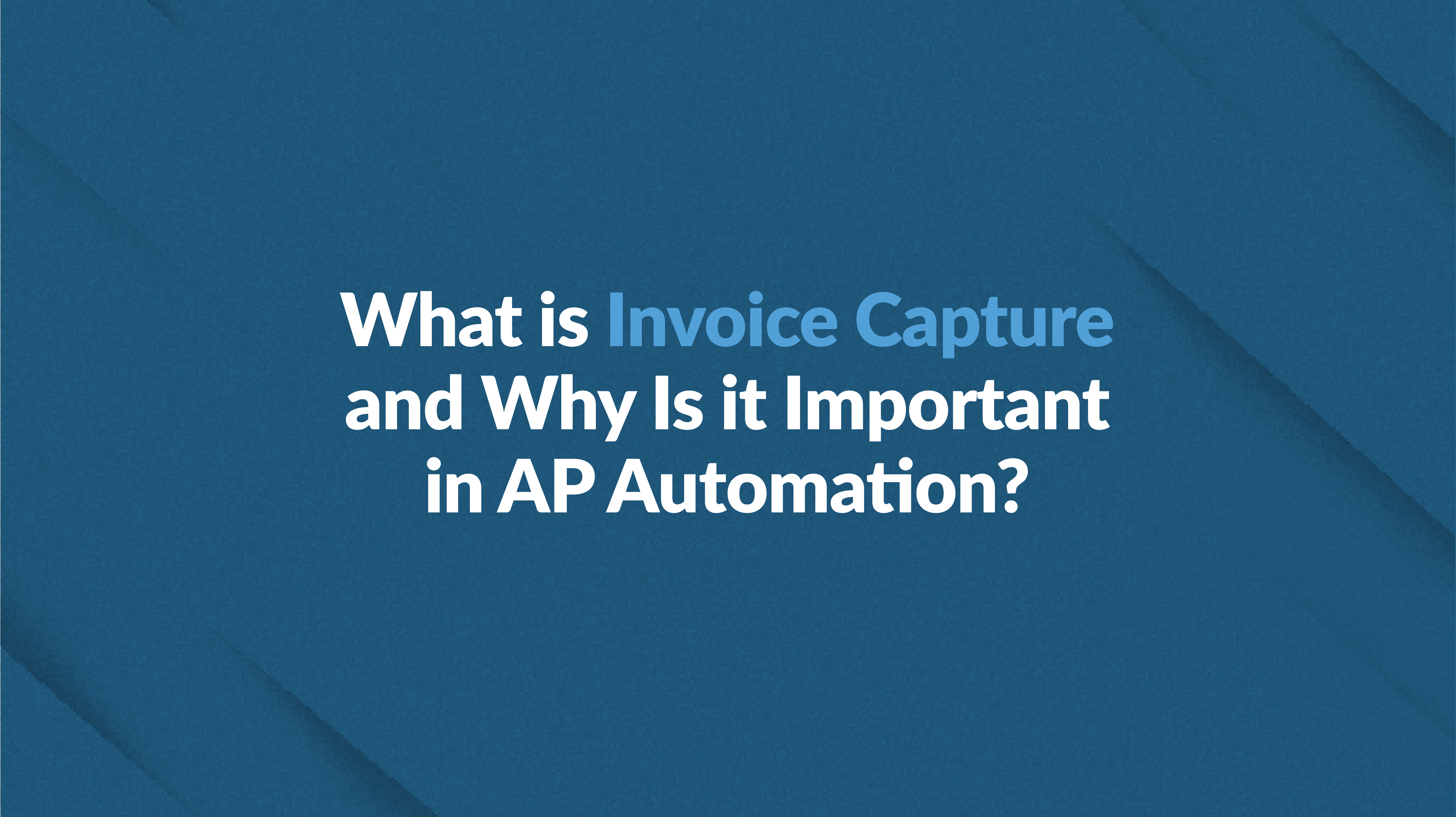Automated Accounts Receivable Programs: Cutting DSO by 30% in Six Months
In today’s economy, speed to cash is as important as speed to market. Companies that let receivables linger for 60, 75, or even 90 days are putting...
6 min read
June 21 2024
by
![]() Chris Cosgrove
Chris Cosgrove

Accounts payable (AP) automation is an important series of steps leading to vendor payment, account reconciliation, and ultimately, improved business growth. While no one step takes precedence over the other, the ability to complete accurate and timely invoice capture using AP automation is becoming a game changer for businesses.
If you are considering AP automation for your operations, this blog will give you a more in-depth picture of the invoice capture process and describe the benefits of using automation technology to manage it.
Accounts payable invoice capture is the initial phase in the AP process where invoice data is collected, verified, and entered into an accounting system. This step is critical because it sets the foundation for subsequent activities such as approval, payment scheduling, and reconciliation. Efficient and accurate invoice capture ensures that your entire AP process runs smoothly and accurately, reducing the risk of errors and delays.
But why is invoice capture so important? Before going into more detail, it’s helpful to know how invoice capture has evolved and take stock of where you are in the process of automation. Ask the following questions:
For decades, there was only one way to capture information from invoices: manual data entry. And that meant taking a paper invoice, reading the information, and entering data line item by line item into accounting software.
The industry average for manual invoice capture and processing is 5 invoices per hour, from data entry and proofing input to correcting any errors and moving the invoice forward for payment. While simple to complete, it’s time-consuming and prone to human error.
As technology has advanced, however, new ways to collect data and transfer it have become available and here are some methods:
Email-Based Capture. Email-based invoice capture is a method where invoices are received and processed through email. Suppliers send their invoices to a designated email address managed by the AP team. This process simplifies the receipt of invoices but still involves paper handling and manual steps to extract and enter data.
Capture begins when a vendor emails an invoice to a specific AP email address. Next, an AP staff member reviews the email, opens the attached invoice, and manually extracts key information such as vendor details, invoice date, item descriptions, quantities, prices, and total amounts. The extracted information is then manually entered into the company's accounting system for further processing, including verification, approval, and payment scheduling.
While not hugely different from paper-based manual invoice capture, the emailing of invoices eliminates the need for physical handling and storage of paper invoices. AP staff also have faster access to invoices, which can expedite the approval and payment cycle. Overall, email-based capture is more cost-effective than handling paper invoices and can streamline the initial stages of invoice processing.
Email-based invoice capture does not come without challenges, however. There is still significant manual labor required for data extraction and entry, making the process time-consuming and susceptible to human error. Variations in invoice formats can also complicate data extraction, increasing the likelihood of mistakes.
Optical Character Recognition (OCR). OCR technology significantly enhances the efficiency and accuracy of AP invoice capture by automating the extraction and processing of invoice data.
Invoice capture begins when physical invoices are scanned or digital invoices such as PDFs are imported into the accounting system. OCR software then converts the text from scanned documents, PDFs, or images into machine-readable data, streamlining the AP process and reducing manual effort. It extracts critical fields like vendor details, invoice number, date, line items, quantities, prices, and total amounts.
After capture, extracted data is validated against predefined templates and business rules to ensure accuracy; any discrepancies are then flagged for manual review. Once validated, the extracted data is automatically entered into the accounting system for processing, including verification, approval, and payment.
OCR technology takes a significant step forward in the data extraction process, speeding up invoice processing and reducing the time required for manual data entry. The automation it provides minimizes human errors, ensuring more precise data capture and reducing instances of payment discrepancies or duplicate entries. Because OCR-based systems can handle large volumes of invoices, it enhances scalability, saves on operational costs, and frees up staff to focus on higher-value tasks.
AP Automation Software. This automation technology revolutionizes the invoice capture process by integrating sophisticated tools such as OCR, machine learning, and AI to automate data extraction, validation, and processing. It minimizes manual effort and enhances efficiency, accuracy, and scalability in managing invoices. Among these systems, your AP staff can verify, code, and route invoices for approval, therefore drastically reducing manual intervention and improving process efficiency.
Invoice capture starts when invoices are received through multiple channels, including email, electronic data interchange (EDI), and web portals. OCR and AI technologies analyze the invoices and automatically extract critical information such as vendor details, invoice number, date, line items, quantities, prices, and total amounts.
After initial capture, the extracted data is cross-referenced against purchase orders, contracts, and other relevant documents to validate accuracy. Machine learning algorithms continually improve this validation process by learning from past discrepancies. The validated data is then routed through automated approval workflows, ensuring compliance with internal policies and accelerating the approval cycle. Finally, approved invoices are seamlessly integrated into the accounting system for payment scheduling and execution.
AP automation is the most efficient form of invoice capture because it automates all data extraction, validates information, and learns patterns in submitted data. It also minimizes human errors, ensuring precise data capture and reducing instances of payment discrepancies or duplicate entries.
Because AP automation technology can handle high volumes of invoices, it’s an ideal tool for growing businesses. Additionally, by lowering manual labor and operational overhead, AP automation reduces costs and frees up staff to focus on more strategic activities. Businesses can also rely on AP automation to assist with adherence to internal policies and regulatory requirements, enhancing audit readiness.
Regardless of how your organization captures invoice data, the importance of this step in the accounts payable process is universal because it serves as a starting point for subsequent AP activities–including verification, approval, payment scheduling, and reconciliation.
Here are reasons investing in adequate invoice capture pays off:
Vendor information, invoice date, item descriptions, quantities, prices, and total amounts are essential for preventing errors that can lead to financial discrepancies. Errors in data capture, such as duplicate payments, incorrect amounts, or wrong vendor details can result in financial losses and damaged vendor relationships.
Accurate and timely capture of invoice data enables businesses to schedule payments appropriately, taking advantage of cash rebates and avoiding late fees. Efficient invoice processing helps maintain a balanced cash flow, ensuring that your organization has sufficient funds to meet its financial obligations while minimizing the cost of borrowing.
Payments resulting from efficient invoice capture help maintain strong relationships with suppliers. Why? Because suppliers are more likely to offer favorable terms and continue their business relationships with organizations that consistently pay on time and accurately. This reliability can lead to better negotiation leverage and potentially lower costs for goods and services, benefiting a business’s bottom line.
Invoice capture is also vital for ensuring compliance with financial regulations and internal policies. Accurate and complete records of invoice data are essential for complying with tax laws, regulatory requirements, and audit standards. Properly captured and stored invoice data ensures that the organization is prepared for internal and external audits, reducing the risk of penalties and reputational damage.
Automated systems in particular can help mitigate the risk of fraud in the AP process. By implementing validation checks and cross-referencing invoice data with purchase orders and delivery receipts, these systems can detect and flag suspicious activities, such as duplicate invoices or fraudulent claims. This enhances the organization's financial security and reduces the potential for financial losses due to fraudulent activities.
Accurate invoice capture provides a wealth of data that can be analyzed to support strategic decision-making. Businesses can gain insights into spending patterns, vendor performance, and payment trends, enabling them to make informed decisions about budgeting, cost management, and vendor selection. This data-driven approach enhances overall financial management and contributes to a business’s long-term success.
As a business grows, the volume of invoices it needs to process increases. In this regard, efficient and scalable invoice capture systems are essential to handle this growth without compromising accuracy or efficiency. Automated systems can easily scale to accommodate higher volumes of invoices, ensuring that the AP process remains robust and effective as the organization expands.
Effective invoice capture is crucial for an AP department to ensure smooth financial operations and maintain strong supplier relationships. Therefore, implementing best practices can streamline processes and improve overall efficiency.
To begin, investing in automated invoice capture software will significantly enhance the accuracy and speed of processing invoices. Automation reduces manual data entry, minimizes errors, and ensures timely processing. It also allows a business to utilize a centralized system for tracking and auditing invoices.
In order to further simplify the capture process, it’s also beneficial to establish a standard invoice format and encourage suppliers to use a consistent template that includes all necessary details; this uniformity makes it easier to process and verify invoices.
Providing regular training to AP staff on the latest invoice capture methods and tools is an essential best practice too, as this helps employees stay updated on new developments and adapt quickly to change. Beyond training employees, make sure to develop clear policies and procedures for invoice submission and processing. Share with internal staff and suppliers to ensure everyone is aligned.
Besides the above recommendations, make time to regularly monitor the invoice capture process and review performance metrics. Use key performance indicators (KPIs) like processing time, error rates, and compliance with policies to measure effectiveness.
Choosing an end-to-end accounts payable automation provider like CloudX is the best way to automate your business’s invoice capture processes. Not only will your department begin streamlining operations at the front end, but you will also be able to customize payment processing according to your unique business needs and the needs of your suppliers.
For more information about APSmart for invoice capture, please fill out our online form here.

In today’s economy, speed to cash is as important as speed to market. Companies that let receivables linger for 60, 75, or even 90 days are putting...

Managing operational costs today often means balancing operational costs against tight margins, making it essential to join a group purchasing...